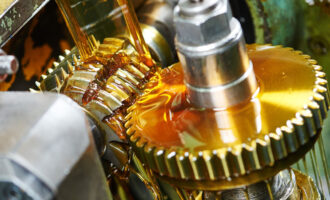
ASTM D3527: Are we using the right system to measure the life of a wheel bearing grease?
For more than three decades, international standards organization ASTM International has supported efforts to improve the accuracy of the ASTM D3527 High-Temperature Wheel Bearing Test — a method introduced to measure the performance and estimate the life of an automotive front wheel bearing. Released in 1976, ASTM D3527 is one of a myriad of industry tests for measuring grease properties and to this day is referenced in a variety of grease specifications. The challenge with any single bearing test, rotating with multiple parts, is the inevitability of variability. This particular test, however, has been plagued with precision issues over a prolonged period.

Barb A. Carfolite, ExxonMobil’s distinguished research associate for Greases and Industrial Oils, says the equipment in the design is old and several measurements are difficult to capture because of the way the method is written. Cars no longer use this type of front wheel bearing configuration, and the test is based on a wheel bearing hub design from the 1960’s.
Carfolite has considerable expertise in grease formulation and testing. The College of New Jersey graduate has worked at ExxonMobil her entire career, spanning almost 40 years of lubricants R&D, originally at Mobil and subsequently at the combined entity from January 2000.
“Leeway with motor selection is a key issue,” says Carfolite. There is greater consistency in bearings than there used to be, but significant variability in the motor selection itself and how the motor is used during the test. “The motor specified in the method is not available. A 120-volt direct current (DC) motor is required, but only 90-volt and 130-volt options are available off the shelf for DC,” she says. Additionally, as the motor ages, its ability to maintain current diminishes.
ASTM D02 proficiency test program results from October 2017 concur with Carfolite’s assertion. While low participation blocked meaningful statistical analysis; of the five labs reported, results fluctuated wildly from 80–260 hours, highlighting the repeatability challenges of this test. “From a formulation perspective, we are always interested in good precision. Product development results with a range greater than average are troubling, especially when related to an industry specification,” says Carfolite.
Despite the obvious precision issues, the ‘Wheel Bearing Life Test’ remains a critical measurement and one that cannot be easily replaced. ASTM D3527 is referenced not only in the NLGI GB and GC certification (ASTM D4950) for automotive service greases but is also quoted in several military and builder standards. The test does have many positive attributes. “It is cost effective, uses a small test unit, and there is a desire to continue to have some type of a bearing test that predicts high temperature grease life,” says Carfolite.
ASTM subcommittee D is acutely aware of the issues with D3527 and has undertaken a significant amount of exploratory work — without realizing a suitable fix. Several test variables were studied and evaluated from the 1980s to 2000s, such as an increase in test severity, cut off sampling time, bearing torque loading, chamber temperature and insulation, alternative cut off calculation, motor variability, packing method variations and motor speed control. Despite this volume of work, the test remains relatively unchanged.

Recent efforts by ExxonMobil to improve the test precision for the industry are starting to show some promise. Autumn Chadwick, automation engineer at ExxonMobil Research and Engineering, presented results of the company’s internal studies and proposed enhancements at the 85th NLGI Annual Meeting, June 9-12, 2018, in Coeur d’Alene, Idaho, U.S.A.
ExxonMobil’s research shows that motor selection is absolutely critical in determining how the life test will run. Variability in motor selection across the industry is believed to be a key driver behind the inconsistency of ASTM round robins seen historically with the test. The ASTM standard calls for a ¼ horsepower (HP) DC motor with 1725 revolutions per minute (RPM). From 2017 onwards, ExxonMobil began swapping their existing 90 VDC motor with one that was more aligned to the test specifications — a 130 VDC, . ¼ HP, 2500 RPM speed-controlled motor with a maximum rated motor torque of 101 oz. in. When they did this “life test repeatability increased greatly,” says Chadwick.
“It is critical to know your motor and how it influences test performance,” she says, while also calling for greater visibility across the industry of motors being employed on these test stands, and the possible compilation of an industry database.
Electric current is also a critical determinant of the test cycle. Though, current is not an accurate way to measure what is happening in the bearing, suggests Carfolite. “We are trying to test grease and measure resistance to rotation or torque as a value to determine EOT [end-of-test], but we are using current as a way to measure that resistance vs measuring it directly.” Are we using the right system of measurement to ascertain the value we require, she asks?
The torque produced is not linearly proportional to motor current draw and current values can vary motor to motor due to power and winding differences. “When the ASTM D3527 High-Temperature Wheel Bearing Test was created, we believe torque meters were not readily available, and at that time the technology that was available was very expensive,” says Carfolite. The ExxonMobil researcher theorises there is an opportunity to improve the standard itself through the addition of a torque meter for a direct torque measurement. One of many prospects for improvement in this test, she says.
The next ASTM meeting will be held at the Atlanta Marriott Marquis in Atlanta, Ga., U.S.A., from 9-13 December 2018. ExxonMobil will share their recent findings with the subcommittee as they look to determine the most appropriate way forward. The company’s key recommendation will be the inclusion of a torque meter, says Carfolite.
Irrespective of the past problems with ASTM D3527, it is critical that improvements are made to this test to help the industry develop greases to meet customer needs. The committee recently voted to extend the test by a further five years, so any enhancements to reliability and precision will no doubt be welcomed by the industry.







